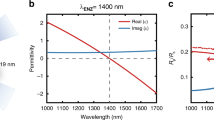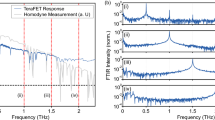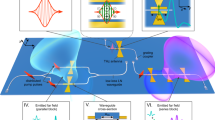Abstract
An efficient, room-temperature-operation continuous-wave terahertz source will greatly benefit compact terahertz system development for high-resolution terahertz spectroscopy and imaging applications. Here, we report highly efficient continuous-wave terahertz emission using nanogap electrodes in a photoconductive antenna-based photomixer. The tip-to-tip nanogap electrode structure provides strong terahertz field enhancement and acts as a nano-antenna to radiate the terahertz wave generated in the active region of the photomixer. In addition, it provides good impedance-matching to the terahertz planar antenna and exhibits a lower RC time constant, allowing more efficient radiation, especially at the higher part of the terahertz spectrum. As a result, the output power of the photomixer with the new nanogap electrode structure in the active region is two orders of magnitude higher than for a photomixer with typical interdigitated electrodes. The terahertz emission bandwidth also increases by a factor of more than two.
This is a preview of subscription content, access via your institution
Access options
Subscribe to this journal
Receive 12 print issues and online access
$209.00 per year
only $17.42 per issue
Buy this article
- Purchase on Springer Link
- Instant access to full article PDF
Prices may be subject to local taxes which are calculated during checkout





Similar content being viewed by others
References
Winnewisser, G. Spectroscopy in the terahertz region. Vibrat. Spectrosc. 8, 241–253 (1995).
Siegel, P. H. Terahertz technology. IEEE Trans. Microw. Theory Tech. 50, 910–928 (2002).
Hu, B. B. & Nuss, M. C. Imaging with terahertz waves. Opt. Lett. 20, 1716–1718 (1995).
Shen, Y. C. et al. Detection and identification of explosives using terahertz pulsed spectroscopic imaging. Appl. Phys. Lett. 86, 241116 (2005).
Tonouchi, M. Cutting-edge terahertz technology. Nature Photon. 1, 97–105 (2007).
Williams, B. S. Terahertz quantum-cascade lasers. Nature Photon. 1, 517–525 (2007).
Qin, Q., Williams, B. S., Kumar, S., Hu, Q. & Reno, J. L. Tuning a terahertz wire laser. Nature Photon. 3, 732–737 (2009).
Amanti, M. I., Fischer, M., Scalari, G., Beck, M. & Faist, J. Low-divergence single-mode terahertz quantum cascade laser. Nature Photon. 3, 586–590 (2009).
Kumar, S. Chan, C. W. I., Hu, Q. & Reno, J. L. A 1.8-THz quantum cascade laser operating significantly above the temperature of ħω/kB . Nature Phys. 7, 166–171 (2011).
Maineult, W. et al. Metal–metal terahertz quantum cascade laser with micro-transverse-electromagnetic-horn antenna. Appl. Phys. Lett. 93, 183508 (2008).
Kumar, S., Hu, Q. & Reno, J. L. 186 K operation of terahertz quantum-cascade lasers based on a diagonal design. Appl. Phys. Lett. 94, 131105 (2009).
Ferguson, B. & Zhang, X. C. Materials for terahertz science and technology. Nature Mater. 1, 26–33 (2002).
Preu, S., Döhler, G. H., Malzer, S., Wang, L. J. & Gossard, A. C. Tunable, continuous-wave terahertz photomixer sources and applications. J. Appl. Phys. 109, 061301 (2011).
McIntosh, K. A. et al. Terahertz photomixing with diode lasers in low-temperature-grown GaAs. Appl. Phys. Lett. 67, 3844–3846 (1995).
Gregory, I. S. et al. Resonant dipole antennas for continuous-wave terahertz photomixers. Appl. Phys. Lett. 85, 1622–1624 (2004).
Brown, E. R., McIntosh, K. A., Nichols, K. B. & Dennis, C. L. Photomixing up to 3.8 THz in low-temperature-grown GaAs. Appl. Phys. Lett. 66, 285–287 (1995).
Brown, E. R. THz generation by photomixing in ultrafast photoconductors. Int. J. High Speed Electron. Syst. 13, 497–545 (2003).
Gregory, I. S. et al. Optimization of photomixers and antennas for continuous-wave terahertz emission. IEEE J. Quant. Electron. 41, 717–728 (2005).
Duffy, S. M. et al. Accurate modeling of dual dipole and slot elements used with photomixers for coherent terahertz output power. IEEE Trans. Microwave Theor. Tech. 49, 1032–1038 (2001).
Mangeney, J. et al. Continuous wave terahertz generation up to 2 THz by photomixing on ion-irradiated In0.53Ga0.47As at 1.55 µm wavelengths. Appl. Phys. Lett. 91, 241102 (2007).
Samir, R. et al. Enhanced terahertz emission from a multilayered low temperature grown GaAs structure. Appl. Phys. Lett. 96, 091101 (2010).
Sartorius, B. et al. Continuous wave terahertz systems exploiting 1.5 µm telecom technologies. Opt. Express 17, 15001–15007 (2009).
Mikulics, M., Marso, M., Lepsa, M., Grützmacher, D. & Kordo, P. Output power improvement in MSM photomixers by modified finger contacts configuration. IEEE Photon. Tech. Lett. 21, 146–148 (2009).
Pendry, J. B., Martin-Moreno, L. & Garcia-Vidal, F. J. Mimicking surface plasmons with structured surfaces. Science 305, 847–848 (2004).
Williams, C. R. et al. Highly confined guiding of terahertz surface plasmon polaritons on structured metal surfaces. Nature Photon. 2, 175–179 (2008).
Williams, C. R. et al. Dual band terahertz waveguiding on a planar metal surface patterned with annular holes. Appl. Phys. Lett. 96, 011101 (2010).
Chen, H. T. et al. Experimental demonstration of frequency-agile terahertz metamaterials. Nature Photon. 2, 295–298 (2008).
Chen, H. T. et al. A metamaterial solid-state terahertz phase modulator. Nature Photon. 3, 148–151 (2009).
Landy, N. I., Sajuyigbe, S., Mock, J. J., Smith, D. R. & Padilla, W. J. Perfect metamaterial absorber. Phys. Rev. Lett. 100, 207402 (2008).
Yu, N. et al. Designer spoof surface plasmon structures collimate terahertz laser beams. Nature Mater. 9, 730–735 (2010).
Seo, M. A. et al. Terahertz field enhancement by a metallic nano slit operating beyond the skin-depth limit. Nature Photon. 3, 152–156 (2009).
Novotny, L. & Hecht, B. Principles of Nano-optics (Cambridge Univ. Press, 2007).
Kawano, Y. & Ishibashi, K. An on-chip near-field terahertz probe and detector. Nature Photon. 2, 618–621 (2008).
Chen, H-T. et al. Active terahertz metamaterials devices. Nature 444, 597–600 (2006).
Large, N., Abb, M., Aizpurua, J. & Muskens, O. L. Photoconductively loaded plasmonic nanoantenna as building block for ultracompact optical switches. Nano Lett. 10, 1741–1746 (2010).
Mühlschlegel, P., Eisler, H. J., Martin, O. J., Hecht, B. & Pohl, D. W. Resonant optical antennas. Science 308, 1607–1609 (2005).
Orton, J. The story of Semiconductors (Oxford Univ. Press, 2004).
Widger, W. K. Jr & Woodall, M. P. Integration of the Planck blackbody radiation function. Bull. Am. Meteorol. Soc. 57, 1217–1219 (1976).
Acknowledgements
H.T. and J.H.T. thank M. Tonouchi for helpful discussions. This work is financially supported by the Agency for Science, Technology and Research (A*STAR), Singapore (grant nos 082 1410038, 092 1540097 and 092 1540098) and by the Leverhulme Trust (UK).
Author information
Authors and Affiliations
Contributions
J.H.T. conceived the idea and supervised the project. H.T. and Q.Y.W. contributed to the fabrication and characterization of the c.w. terahertz photomixer. M.S., Z.N.C., S.A.M. and B.W. contributed to the theory and simulation. H.T. and S.J.C. contributed to the wafer growth. C.C.C., S.G.Y. and A.J.D. contributed to the nanofabrications. H.T., J.H.T., B.W., M.S. and S.A.M. contributed to writing the manuscript. All authors discussed the results and contributed to the article.
Corresponding author
Ethics declarations
Competing interests
The authors declare no competing financial interests.
Supplementary information
Supplementary information
Supplementary information (PDF 285 kb)
Rights and permissions
About this article
Cite this article
Tanoto, H., Teng, J., Wu, Q. et al. Greatly enhanced continuous-wave terahertz emission by nano-electrodes in a photoconductive photomixer. Nature Photon 6, 121–126 (2012). https://doi.org/10.1038/nphoton.2011.322
Received:
Accepted:
Published:
Issue Date:
DOI: https://doi.org/10.1038/nphoton.2011.322
This article is cited by
-
Programmable terahertz chip-scale sensing interface with direct digital reconfiguration at sub-wavelength scales
Nature Communications (2019)
-
Terahertz integrated electronic and hybrid electronic–photonic systems
Nature Electronics (2018)
-
Hybrid Computational Simulation and Study of Terahertz Pulsed Photoconductive Antennas
Journal of Infrared, Millimeter, and Terahertz Waves (2016)
-
Nano-antenna in a photoconductive photomixer for highly efficient continuous wave terahertz emission
Scientific Reports (2013)
-
Retraction Note: Greatly enhanced continuous-wave terahertz emission by nano-electrodes in a photoconductive photomixer
Nature Photonics (2013)



